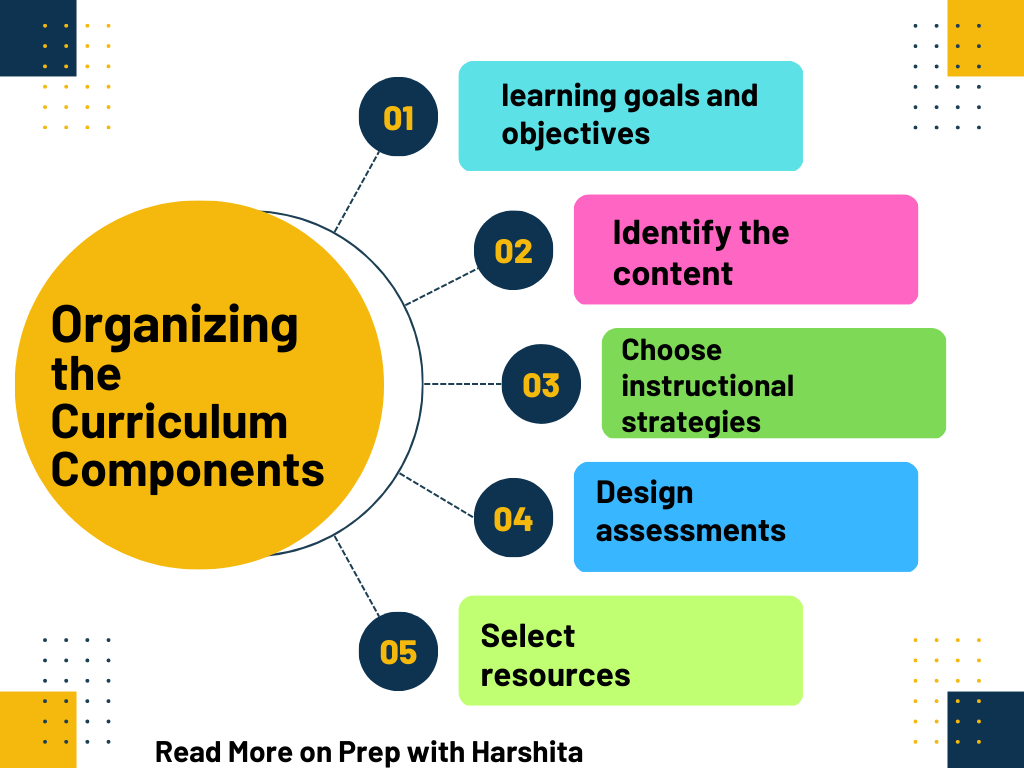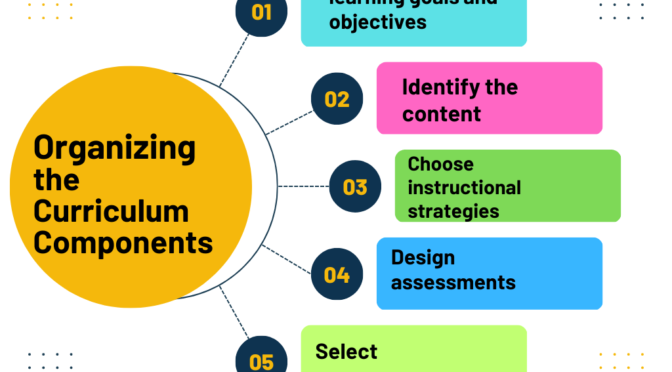Organizing the curriculum components involves a process of identifying and arranging the various elements that make up the curriculum to support effective teaching and learning.
Here are the key steps to organizing the curriculum components:
- Determine the learning goals and objectives: The first step is to define the learning outcomes that the curriculum is intended to achieve. This involves identifying the specific knowledge, skills, and competencies that students should acquire. Learning goals and objectives should be clear, measurable, and aligned with the overall mission and vision of the educational program.
- Identify the content to be covered: The next step is to determine the specific content that will be included in the curriculum. This may involve selecting topics, themes, or units of study that are aligned with the learning goals and objectives. It is important to ensure that the content is relevant, engaging, and developmentally appropriate for the target audience.
- Choose instructional strategies and activities: Once the learning goals, objectives, and content have been identified, the next step is to select instructional strategies and activities that will be used to teach the material. This may involve a variety of approaches, such as lectures, discussions, project-based learning, or experiential learning. The key is to select strategies that are effective, engaging, and aligned with the learning objectives.
- Design assessments: Assessments are an essential component of the curriculum as they allow educators to evaluate student learning and progress. This involves designing formative and summative assessments that are aligned with the learning goals and objectives. Assessments may take many forms, such as tests, quizzes, essays, presentations, or projects. It is important to ensure that assessments are fair, valid, and reliable.
- Select resources: To support the implementation of the curriculum, educators need access to a range of resources, such as textbooks, technology, manipulatives, and other materials. It is important to select resources that are aligned with the learning goals and objectives. It should support student engagement and learning and be accessible to all students.
- Ensure alignment: Finally, it is essential to ensure that all of the curriculum components are aligned with each other and with the overall goals of the educational program. This involves reviewing and revising the curriculum regularly to ensure that it remains current, relevant, and effective.
Overall, organizing the curriculum components is a complex process that requires careful planning, collaboration, and ongoing evaluation and refinement. By following these steps, educators can develop a coherent and effective curriculum that supports student learning and achievement.
Also Read: Factors affecting Curriculum Change



equilibrado de rotores
Aparatos de equilibrado: esencial para el desempeño uniforme y efectivo de las dispositivos.
En el ámbito de la tecnología moderna, donde la efectividad y la fiabilidad del dispositivo son de gran relevancia, los equipos de calibración tienen un papel vital. Estos aparatos adaptados están creados para ajustar y estabilizar piezas giratorias, ya sea en herramientas industrial, automóviles de movilidad o incluso en aparatos hogareños.
Para los profesionales en soporte de equipos y los técnicos, utilizar con equipos de calibración es fundamental para proteger el rendimiento uniforme y estable de cualquier mecanismo móvil. Gracias a estas opciones innovadoras innovadoras, es posible limitar considerablemente las oscilaciones, el sonido y la carga sobre los sujeciones, prolongando la longevidad de piezas costosos.
Igualmente relevante es el rol que tienen los aparatos de balanceo en la asistencia al comprador. El asistencia especializado y el soporte continuo utilizando estos equipos permiten dar asistencias de gran excelencia, aumentando la bienestar de los clientes.
Para los titulares de empresas, la aporte en estaciones de balanceo y sensores puede ser fundamental para aumentar la rendimiento y desempeño de sus aparatos. Esto es sobre todo importante para los empresarios que administran pequeñas y intermedias organizaciones, donde cada detalle vale.
Asimismo, los equipos de balanceo tienen una amplia aplicación en el ámbito de la protección y el control de calidad. Permiten detectar probables problemas, previniendo arreglos costosas y problemas a los sistemas. Incluso, los información recopilados de estos equipos pueden utilizarse para maximizar métodos y incrementar la exposición en buscadores de investigación.
Las áreas de implementación de los equipos de ajuste comprenden múltiples ramas, desde la fabricación de vehículos de dos ruedas hasta el monitoreo ecológico. No afecta si se habla de enormes fabricaciones manufactureras o pequeños espacios hogareños, los sistemas de equilibrado son indispensables para proteger un operación efectivo y sin presencia de detenciones.
[b]Prevent Vibration Damage – Get Professional Balancing with Balanset-1A[/b]
Unbalanced rotors can cause serious damage to your machinery. Bearings wear out faster, motors consume more power, and failures lead to expensive repairs. [b]Balanset-1A[/b] provides professional-grade vibration diagnostics and balancing, helping businesses save money and improve reliability.
[b]Key Benefits:[/b]
– [b]Accurate & fast diagnostics[/b] – Identifies imbalance before it causes damage
– [b]Portable & efficient[/b] – Suitable for field and workshop use
– [b]User-friendly software[/b] – No special training required
[b]Choose Your Kit:[/b]
[url=https://www.amazon.es/dp/B0DCT5CCKT]Full Kit on Amazon[/url] – Includes all necessary sensors, software, and a protective case
Price: [b]€2250[/b]
[url=https://www.amazon.es/dp/B0DCT5CCKT][img]https://i.postimg.cc/SXSZy3PV/4.jpg[/img][/url]
[url=https://www.amazon.es/dp/B0DCT4P7JR]OEM Kit on Amazon[/url] – More affordable, comes with basic components
Price: [b]€1978[/b]
[url=https://www.amazon.es/dp/B0DCT4P7JR][img]https://i.postimg.cc/cvM9G0Fr/2.jpg[/img][/url]
Protect your equipment today with [b]Balanset-1A[/b]!
Balanset-1A: Innovative Mobile Balancer & Vibration Analyzer
Professional Dynamic Balancing Solution
Balanset-1A represents an advanced solution for rotor balancing of rotors in their own bearings, developed by Estonian company Vibromera OU. The device provides professional equipment balancing at €1,751, which is substantially less expensive than traditional vibration analyzers while retaining exceptional measurement accuracy. The system allows on-site balancing directly at the equipment’s operational location without requiring removal, which is essential for reducing production downtime.
About the Manufacturer
Vibromera OU is an Estonian company specializing in the design and production of devices for technical diagnostics of industrial equipment. The company is registered in Estonia (registration number 14317077) and has representatives in Portugal.
Contact Information:
Official website: https://vibromera.eu/shop/2/
Technical Specifications
Measuring Parameters
Balanset-1A delivers high-precision measurements using a dual-channel vibration analysis system. The device measures RMS vibration velocity in the range of 0-80 mm/s with an accuracy of ±(0.1 + 0.1?Vi) mm/s. The operating frequency range is 5-550 Hz with potential extension to 1000 Hz. The system supports rotational speed measurement from 250 to 90,000 RPM with phase angle determination accuracy of ±1 degree.
Operating Principle
The device employs phase-sensitive vibration measurement technology with MEMS accelerometers ADXL335 and laser tachometry. Two uniaxial accelerometers measure mechanical oscillations proportional to acceleration, while a laser tachometer generates pulse signals for determining rotation frequency and phase angle. Digital signal processing includes FFT analysis for frequency analysis and specialized algorithms for automatic computation of correction masses.
Full Kit Components
The standard Balanset-1A delivery includes:
Measurement unit with USB interface – primary module with integrated preamplifiers, integrators, and ADC
2 vibration sensors (accelerometers) with 4m cables (optionally 10m)
Optical sensor (laser tachometer) with 50-500mm measuring distance
Magnetic stand for sensor mounting
Electronic scales for exact measurement of corrective masses
Software for Windows 7-11 (32/64-bit)
Plastic transport case
Complete set of cables and documentation
Performance Capabilities
Vibrometer Mode
Balanset-1A operates as a complete vibration analyzer with abilities for measuring overall vibration level, FFT spectrum analysis up to 1000 Hz, calculating amplitude and phase of the fundamental frequency (1x), and continuous data recording. The system offers visualization of time signals and spectral analysis for equipment condition diagnostics.
Balancing Mode
The device supports one-plane (static) and dual-plane (dynamic) balancing with automatic calculation of corrective masses and their installation angles. The unique influence coefficient saving function allows substantial acceleration of follow-up balancing of identical equipment. A dedicated grinding wheel balancing mode uses the three-correction-weight method.
Software
The user-friendly program interface provides step-by-step guidance through the balancing process, making the device usable to personnel without special training. Key functions include:
Automatic tolerance calculation per ISO 1940
Polar diagrams for imbalance visualization
Result archiving with report generation capability
Metric and imperial system support
Multilingual interface (English, German, French, Polish, Russian)
Fields of Use and Equipment Types
Industrial Equipment
Balanset-1A is effectively applied for balancing fans (centrifugal, axial), pumps (hydraulic, centrifugal), turbines (steam, gas), centrifuges, compressors, and electric motors. In manufacturing facilities, the device is used for balancing grinding wheels, machine spindles, and drive shafts.
Agricultural Machinery
The device provides particular value for agriculture, where reliable operation during season is essential. Balanset-1A is employed for balancing combine threshing drums, shredders, mulchers, mowers, and augers. The capability to balance on-site without equipment disassembly permits eliminating costly downtime during busy harvest periods.
Specialized Equipment
The device is successfully used for balancing crushers of various types, turbochargers, drone propellers, and other high-speed equipment. The speed frequency range from 250 to 90,000 RPM covers practically all types of industrial equipment.
Benefits Over Similar Products
Economic Efficiency
At a price of €1,751, Balanset-1A delivers the functionality of devices costing €10,000-25,000. The investment breaks even after preventing just 2-3 bearing failures. Savings on external balancing specialist services totals thousands of euros annually.
Ease of Use
Unlike complicated vibration analyzers requiring months of training, mastering Balanset-1A takes 3-4 hours. The step-by-step guide in the software permits professional balancing by personnel without special vibration diagnostics training.
Portability and Autonomy
The complete kit weighs only 4 kg, with power supplied through the laptop’s USB port. This permits balancing in field conditions, at remote sites, and in hard-to-reach locations without external power supply.
Versatile Application
One device is appropriate for balancing the widest spectrum of equipment – from small electric motors to large industrial fans and turbines. Support for one and two-plane balancing covers all common tasks.
Real Application Results
Drone Propeller Balancing
A user achieved vibration reduction from 0.74 mm/s to 0.014 mm/s – a 50-fold improvement. This demonstrates the exceptional accuracy of the device even on small rotors.
Shopping Center Ventilation Systems
Engineers effectively balanced radial fans, achieving reduced energy consumption, abolished excessive noise, and extended equipment lifespan. Energy savings offset the device cost within several months.
Agricultural Equipment
Farmers note that Balanset-1A has become an indispensable tool preventing costly breakdowns during peak season. Reduced vibration of threshing drums led to lower fuel consumption and bearing wear.
Pricing and Delivery Terms
Current Prices
Complete Balanset-1A Kit: €1,751
OEM Kit (without case, stand, and scales): €1,561
Special Offer: €50 discount for newsletter subscribers
Wholesale Discounts: up to 15% for orders of 4+ units
Acquisition Options
Official Website: vibromera.eu (recommended)
eBay: trusted sellers with 100% rating
Industrial Distributors: through B2B channels
Payment and Shipping Terms
Payment Methods: PayPal, bank cards, bank transfer
Shipping: 10-20 business days by international mail
Shipping Cost: from $10 (economy) to $95 (express)
Warranty: manufacturer’s warranty
Technical Support: included in price
Summary
Balanset-1A stands as an optimal solution for organizations aiming to implement an effective equipment balancing system without significant capital expenditure. The device democratizes access to professional balancing, permitting small enterprises and service centers to provide services at the level of large industrial companies.
The combination of affordable price, ease of use, and professional capabilities makes Balanset-1A an essential tool for modern technical maintenance. Investment in this device is an investment in equipment reliability, lower operating costs, and enhanced competitiveness of your business.